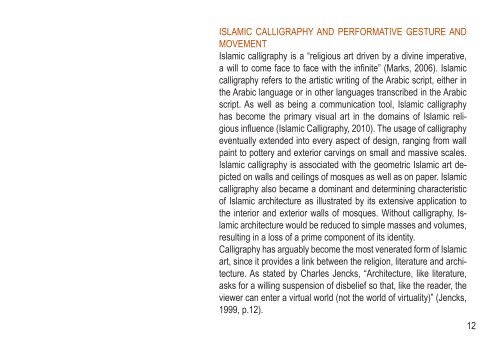The Dance of Soma and Psyche This thesis is submitted to the AUT ...
The Dance of Soma and Psyche This thesis is submitted to the AUT ...
The Dance of Soma and Psyche This thesis is submitted to the AUT ...
Create successful ePaper yourself
Turn your PDF publications into a flip-book with our unique Google optimized e-Paper software.
ISLAMIC CALLIGRAPHY AND PERFORMATIVE GESTURE AND<br />
MOVEMENT<br />
Islamic calligraphy <strong>is</strong> a “religious art driven by a divine imperative,<br />
a will <strong>to</strong> come face <strong>to</strong> face with <strong>the</strong> infinite” (Marks, 2006). Islamic<br />
calligraphy refers <strong>to</strong> <strong>the</strong> art<strong>is</strong>tic writing <strong>of</strong> <strong>the</strong> Arabic script, ei<strong>the</strong>r in<br />
<strong>the</strong> Arabic language or in o<strong>the</strong>r languages transcribed in <strong>the</strong> Arabic<br />
script. As well as being a communication <strong>to</strong>ol, Islamic calligraphy<br />
has become <strong>the</strong> primary v<strong>is</strong>ual art in <strong>the</strong> domains <strong>of</strong> Islamic religious<br />
influence (Islamic Calligraphy, 2010). <strong>The</strong> usage <strong>of</strong> calligraphy<br />
eventually extended in<strong>to</strong> every aspect <strong>of</strong> design, ranging from wall<br />
paint <strong>to</strong> pottery <strong>and</strong> exterior carvings on small <strong>and</strong> massive scales.<br />
Islamic calligraphy <strong>is</strong> associated with <strong>the</strong> geometric Islamic art depicted<br />
on walls <strong>and</strong> ceilings <strong>of</strong> mosques as well as on paper. Islamic<br />
calligraphy also became a dominant <strong>and</strong> determining character<strong>is</strong>tic<br />
<strong>of</strong> Islamic architecture as illustrated by its extensive application <strong>to</strong><br />
<strong>the</strong> interior <strong>and</strong> exterior walls <strong>of</strong> mosques. Without calligraphy, Islamic<br />
architecture would be reduced <strong>to</strong> simple masses <strong>and</strong> volumes,<br />
resulting in a loss <strong>of</strong> a prime component <strong>of</strong> its identity.<br />
Calligraphy has arguably become <strong>the</strong> most venerated form <strong>of</strong> Islamic<br />
art, since it provides a link between <strong>the</strong> religion, literature <strong>and</strong> architecture.<br />
As stated by Charles Jencks, “Architecture, like literature,<br />
asks for a willing suspension <strong>of</strong> d<strong>is</strong>belief so that, like <strong>the</strong> reader, <strong>the</strong><br />
viewer can enter a virtual world (not <strong>the</strong> world <strong>of</strong> virtuality)” (Jencks,<br />
1999, p.12).<br />
12

















